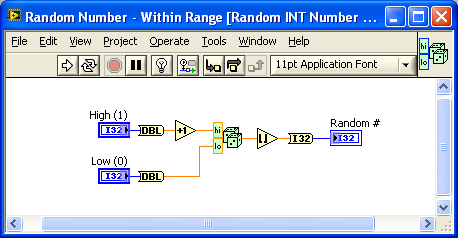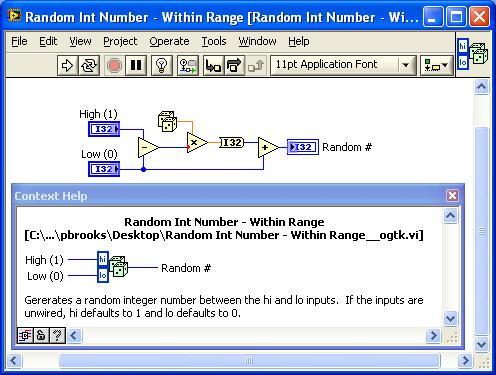By Jim Kring (Copied from OpenG forums; posted there 21 April 2008 - 05:17 PM)
Proposal
I propose that we add support to the "Random Number - Within Range" for integer values by making it a polymorphic function that outputs a uniform distribution for integer inputs (that includes both the Low and High input values). Behavior for floating point inputs would remain unchanged.
Background
There have been a couple recent discussions about generating random integers with the "Random Number - Within Range" function, shown below:
When using the "Random Number - Within Range" function with integer inputs, most people (incorrectly) assume that the output will have a uniform distribution of integers between High and Low. When, in reality, the High and Low values will have half the rate of occurence than the values between High and Low, as shown in the screenshot and example VI, below:
EXAMPLE___Problem_with_Random_Integer_Generation.vi
Let's look at why this happens. Say we have a range from 1 to 10. Values from 1 to 1.5 will be rounded to 1. Values from 1.5 to 2.5 will be rounded to 2, values from 2.5 to 3.5 will be rounded to 3, ..., ..., .., values from 8.5 to 9.5 will be rounded to 9, and values from 9.5 to 10 will be rounded to 10.
As you can see, the values of 1 and 10 each occur in a range of 0.5 out of 9, whereas the values of 2 through 9 each occur in a range of 1 out of 9. 1 and 10 have half the rate of occurence of 2 through 9.
The solution is to extend the total range to High + 1 and then round the output value down, as shown in the screenshot, below:
With this correction, the distribution is now uniform, as shown below:
Open Issues
Convert to Poly VI or create a new, seperate VI for integers?
25]The Polymorphic VI can be named "Random Number - Within Range.vi__ogtk.vi", so that replaces existing instances of the DBL implementation in users' code. For users' existing code that is inputting floating point values into this function, the DBL poly instance will be used and thier code will remain unchanged. For users' existing code that is inputing integer values into this function, the new integer implementation instances will be used. This choice relies on the assumption that the new integer behavior is desired whenever integers are wired into this function. An alternate approach would be to simply add a new, seperate VI for the integer types -- e.g., we might call this Random Integer.






